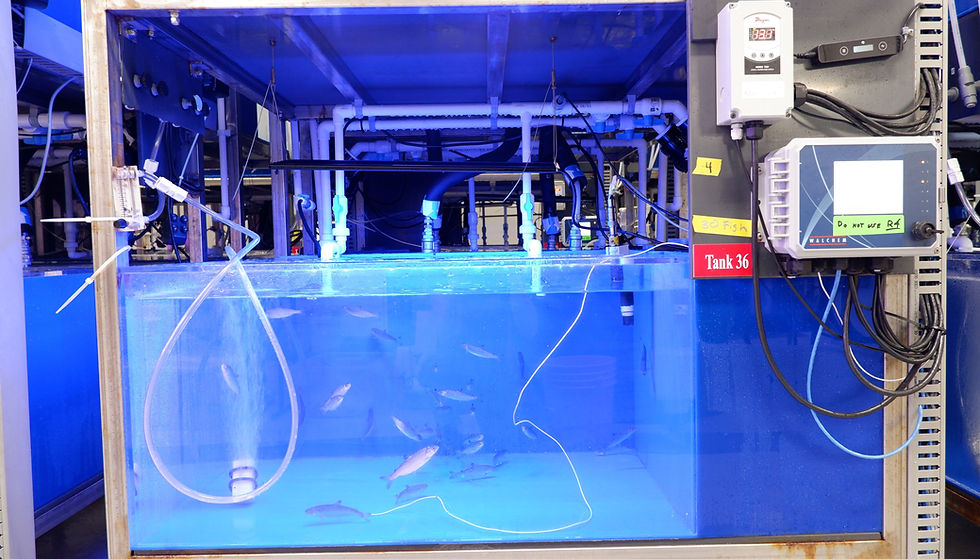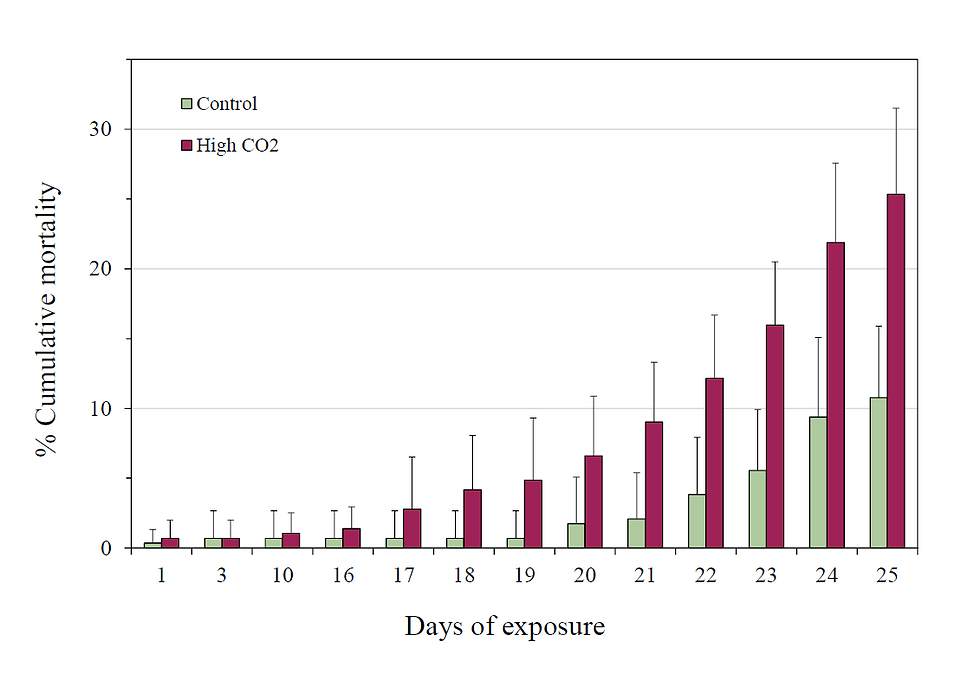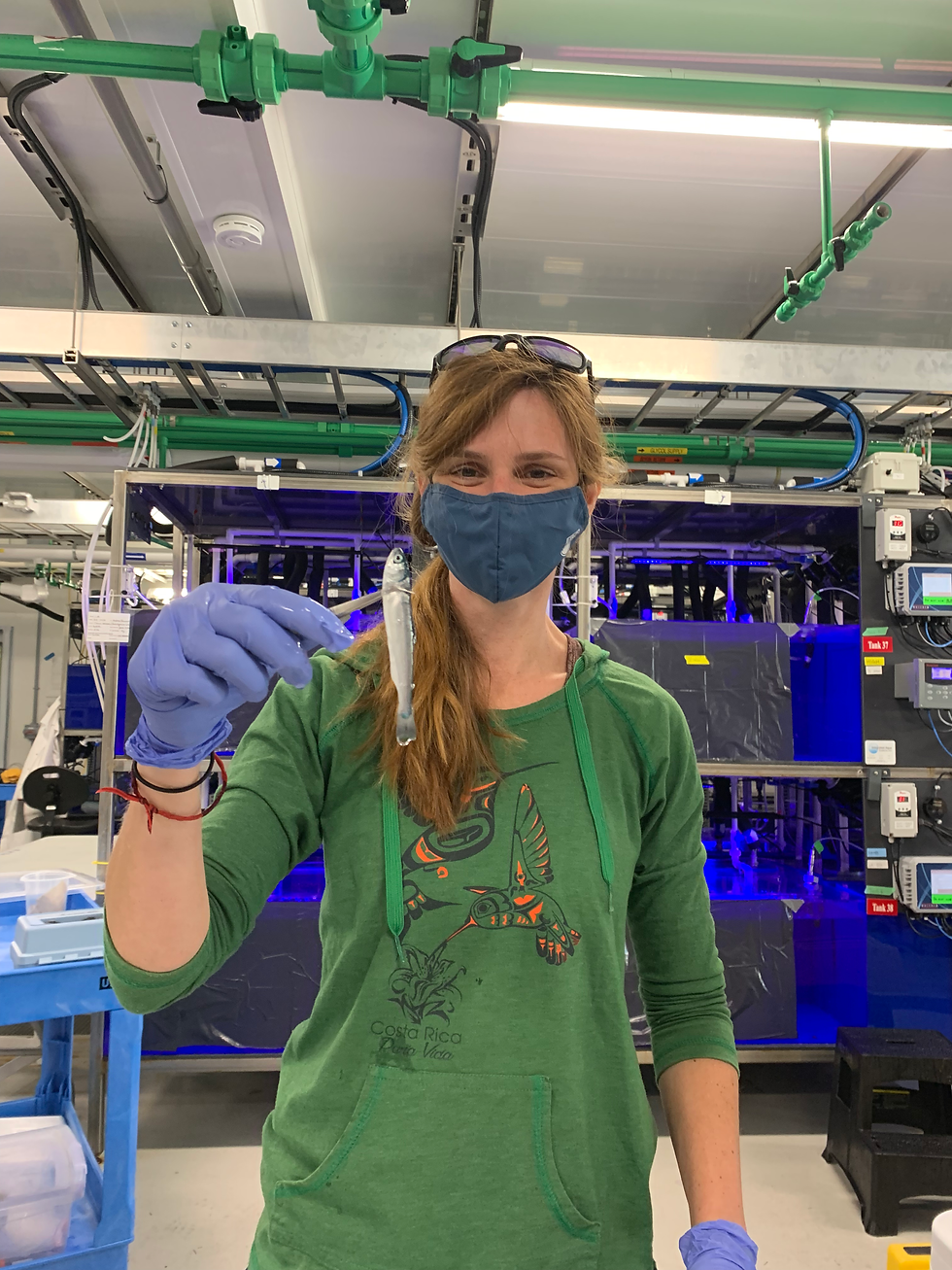New Paper: High sensitivity to ocean acidification in wild out-migrating juvenile Pacific salmon is not impacted by feeding success
- OA CoP

- Aug 12
- 5 min read
Across Canada, salmon are one of the most valuable and culturally significant fisheries and aquaculture species. However, salmon populations are declining worldwide. Salmon are anadromous, meaning they migrate between fresh and marine waters as juveniles, with the variable and changing coastal conditions they must navigate presenting a challenge for survival. Climate change, ocean acidification, and the resulting changing ocean conditions along salmon migratory routes in areas like British Columbia are therefore a concern for long-term population stability. We interviewed Dr. Andrea Frommel, lead author of a new study that investigated how juvenile Pacific salmon are impacted by ocean acidification and changes in food availability and how these impacts can be identified in wild fish.
Dr. Frommel is an Assistant Professor and Chair of Sustainable Aquaculture in the Faculty of Land and Food Systems at the University of British Columbia in Canada. Dr. Frommel has a BSc in Marine Biology, an MSc in Biological Oceanography, and a PhD in Fisheries Biology. She specializes in climate change impacts and environmental stressors in early life stages of commercial fish, as well as sustainable aquaculture.

For those of us not familiar with your area of research, could you give us a little bit of background on your research?
"I am looking at how additional stressors, such as ocean acidification and limited food availability, affect [Pacific salmon's] ability to successfully transition to life at sea."
"I research how environmental stressors associated with climate change (ocean acidification, warming, hypoxia…) affect the physiology and development of early life stages of fish that are commercially important for fisheries and/or aquaculture. My current focus is on the locally important Pacific salmon and herring, as these species groups have unique life history strategies: Pacific salmon are anadromous and migrate from freshwater to seawater as juveniles, which is a physiologically challenging phase of their life and a bottleneck to survival for these species. I am looking at how additional stressors, such as ocean acidification and limited food availability, affect their ability to successfully transition to life at sea. Pacific herring, on the other hand, are benthic and intertidal spawners. This means that they attach their eggs to substrate, typically rocks or algae, and during low tide embryos are exposed to air for hours at a time. I am looking at how the substrate and air exposure can influence their tolerance to environmental challenges, such as hypoxia and ocean acidification."
What was the motivation or inspiration for this research?
"We know that chum populations are currently doing very poorly for reasons not quite understood. Early marine life seems to be a bottleneck for some of the Pacific salmon species, as they have to migrate through an area with challenging ocean conditions, termed the Tidal Mixing Zone, to get to the open sea. These challenges include high carbon dioxide levels and low food supply, but how these conditions may affect juvenile chum was unknown. Previous research has shown carbon dioxide effects to be mitigated by high food supply. We had previously published two papers on ocean acidification effects in pink and chinook salmon, but had not included food as a co-varying factor. Also, chum are one of the Pacific salmon species to migrate out to sea at the smallest size and earliest age, making them potentially more vulnerable to these challenges. We devised an experiment to test the combined effects of ocean acidification and food availability on juvenile chum from this area."

What was the main question of this research?
"The main question was, how do low feeding success and high carbon dioxide synergistically affect juvenile chum salmon during their natural migration to sea."
How did you go about answering your question?
"We conducted the experiment at Hakai’s facility on Quadra Island, which is located right in the Tidal Mixing Zone. We caught wild chum salmon by boat, brought them back to the Marna Lab and exposed them to ocean acidification conditions for 3.5 weeks. A third of the fish were fed to satiation, a third at half that rate and a third were unfed. We expected to see an effect of ocean acidification on the condition and ionoregulatory ability in chum, but that these effects would disappear with ample food supply. Kristi Miller (DFO) had just developed fitchips for assessing transcriptomic responses to hypoxia and salinity challenges in chum and we teamed up with her to assess transcriptomic effects of carbon dioxide and food. These fitchips help determine the recent environmental stress history of a wild-caught fish through non-lethal gill clip sampling."

What were the main findings of your work?
"Our main findings were that chum salmon were highly sensitive to ocean acidification with 3 times higher mortality compared to the control. The main pathways that were affected were ionoregulatory genes, suggesting ionoregulatory failure in response to carbon dioxide. Feeding rate did not affect this high sensitivity and while mortality was unaffected by food deprivation, it did lower their condition and immune system."

Did you find anything unexpected?
"Given that our previous experiments with pink and chinook salmon did not show high sensitivity to carbon dioxide, the high mortality in chum in response carbon dioxide was unexpected. Furthermore, many studies have suggested that the pathway of carbon dioxide stress is energy limitation – when fish have to expend a lot of energy regulating a respiratory acidosis in high carbon dioxide, this energy is not available for other important processes, such as osmoregulation, growth and development. Therefore, when fish are well-fed, they should be able to fuel those extra energy costs. However, our data suggests ionoregulatory failure, particularly in small individuals, regardless of food availability. Another surprising result was that we were able to detect a starvation signal in the gills, a tissue that is not usually associated with metabolic activity. Thus, fitchips are a useful tool to determine recent exposure to carbon dioxide and food in wild juvenile salmon."
"Given that our previous experiments with pink and chinook salmon did not show high sensitivity to carbon dioxide, the high mortality in chum in response carbon dioxide was unexpected."
What is the one take-home of this work that you want everyone to know or remember?
"One important take-away is that not all salmon are equal. This is the third species of Pacific salmon we’ve worked with and so far, all have shown unique responses to carbon dioxide. Additionally, juveniles are not just small adults. Their bodies respond to environmental stressors very differently than adult fish. To better manage and conserve Pacific salmon, we need to know species-specific and life stage specific responses to environmental conditions and focus management efforts on the vulnerable stages that are potential bottlenecks to survival."

Read Frommel et al., 2025 here (open access):
Citation: Frommel. A. Y., Akbarzadeh A., Chalifoux, V., Ming, T. J., Collicutt, B., Rolheiser, K., Opie, R., Miller, K. M., Brauner, C. J., Hunt, B. P. V. 2025. High sensitivity to ocean acidification in wild out-migrating juvenile Pacific salmon is not impacted by feeding success. Ecological Applications. 35:e70058.
To learn more about Dr. Frommel and her research, please visit:
Acknowledgements:
Thanks to Dr. Andrea Frommel for taking the time to answer our questions and provide insight on this important new research.



Comments